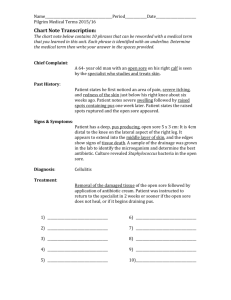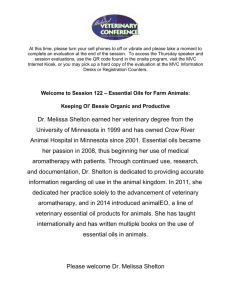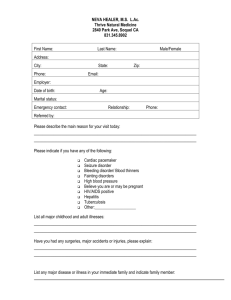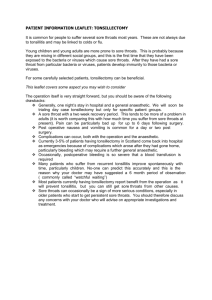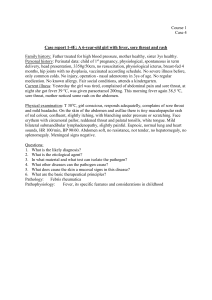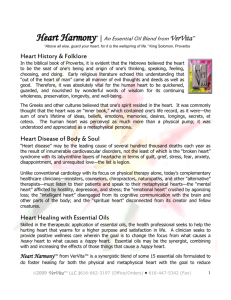Sore to Soar™ Detailed Flyer
advertisement
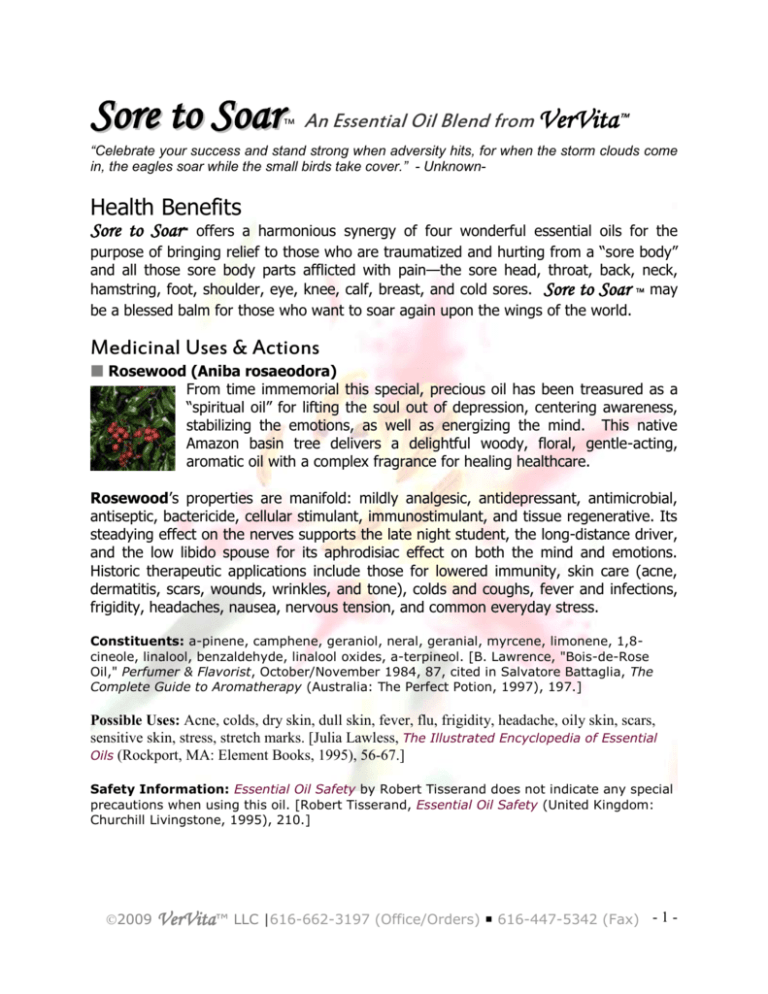
Sore to Soar TM An Essential Oil Blend from VerVita™ “Celebrate your success and stand strong when adversity hits, for when the storm clouds come in, the eagles soar while the small birds take cover.” - Unknown- Health Benefits Sore to Soar™ offers a harmonious synergy of four wonderful essential oils for the purpose of bringing relief to those who are traumatized and hurting from a “sore body” and all those sore body parts afflicted with pain—the sore head, throat, back, neck, hamstring, foot, shoulder, eye, knee, calf, breast, and cold sores. Sore to Soar TM may be a blessed balm for those who want to soar again upon the wings of the world. Medicinal Uses & Actions Rosewood (Aniba rosaeodora) From time immemorial this special, precious oil has been treasured as a “spiritual oil” for lifting the soul out of depression, centering awareness, stabilizing the emotions, as well as energizing the mind. This native Amazon basin tree delivers a delightful woody, floral, gentle-acting, aromatic oil with a complex fragrance for healing healthcare. Rosewood’s properties are manifold: mildly analgesic, antidepressant, antimicrobial, antiseptic, bactericide, cellular stimulant, immunostimulant, and tissue regenerative. Its steadying effect on the nerves supports the late night student, the long-distance driver, and the low libido spouse for its aphrodisiac effect on both the mind and emotions. Historic therapeutic applications include those for lowered immunity, skin care (acne, dermatitis, scars, wounds, wrinkles, and tone), colds and coughs, fever and infections, frigidity, headaches, nausea, nervous tension, and common everyday stress. Constituents: a-pinene, camphene, geraniol, neral, geranial, myrcene, limonene, 1,8cineole, linalool, benzaldehyde, linalool oxides, a-terpineol. [B. Lawrence, "Bois-de-Rose Oil," Perfumer & Flavorist, October/November 1984, 87, cited in Salvatore Battaglia, The Complete Guide to Aromatherapy (Australia: The Perfect Potion, 1997), 197.] Possible Uses: Acne, colds, dry skin, dull skin, fever, flu, frigidity, headache, oily skin, scars, sensitive skin, stress, stretch marks. [Julia Lawless, The Illustrated Encyclopedia of Essential Oils (Rockport, MA: Element Books, 1995), 56-67.] Safety Information: Essential Oil Safety by Robert Tisserand does not indicate any special precautions when using this oil. [Robert Tisserand, Essential Oil Safety (United Kingdom: Churchill Livingstone, 1995), 210.] 2009 VerVita™ LLC |616-662-3197 (Office/Orders) 616-447-5342 (Fax) -1- Spruce (Picea alba) Distilled from young branches and leaves for a pleasant pine needle aroma, Spruce exhibits many beneficial, therapeutic properties including antispasmodic, bactericide, immune, tonic, antifungal, antiinflammatory, antiseptic, and a cortisone-like effect. Traditional usages include treatment for cold hands and feet, varicose veins, goiter, rheumatism, arthritis, athlete’s foot, candida, eczema, psoriasis, asthma, bronchitis, cough, cold and flu, sore throat, sinusitis, and pneumonia. Constituents: Pinenes, limonene, bornyl acetate, tricyclene, phellandrene, myrcrene, thujone, dipentene, cadinene. [Julia Lawless, The Illustrated Encyclopedia of Essential Oils (Rockport, MA: Element Books, 1995), 231.] Possible Uses: Coughing, depression. [Julia Lawless, The Illustrated Encyclopedia of Essential Oils (Rockport, MA: Element Books, 1995), 62-66.] Safety Information: Essential Oil Safety by Robert Tisserand does not indicate any special precautions when using this oil. [Robert Tisserand, Essential Oil Safety (United Kingdom: Churchill Livingstone, 1995), 210.] Frankincense (Boswellia carteri) Meaning “real incense” from Medieval French, Frankincense is best known as one of the three priceless gifts of the Wise Men in the Christmas story. Its sweet balsamic aroma made it suitable for temple and altar liturgies as a sacred fumigant and ritual incense in the Middle East. Its action on the nervous system reduced anxiety and nervous tension by slowing down and deepening respiration, thereby making it suitable for spiritual use in prayer and meditation. Traditionally, Frankincense is best known for its benefits to the skin and respiratory system. Its actions include antiseptic, astringent, analgesic, anticatarrhal, antiinflammatory, rejuvenating, and toning. Historically, it was often used for respiratory infections and coughs, colds and fevers, and skin conditions such as scars, wrinkles, stretch marks, wounds, eczema, pimples and boils. Constituents: Limonene, Pinene, Borneol, Farnesol, Phellandrene, Myrcene [Shirley Price, The Aromatherapy Workbook (Hammersmith, London: Thorsons, 1993), 54-5.] Possible Uses: Anxiety, asthma, bronchitis, extreme coughing, scars, stress, stretch marks. [Julia Lawless, The Illustrated Encyclopedia of Essential Oils (Rockport, MA: Element Books, 1995), 59-67.] Safety Information: Essential Oil Safety by Robert Tisserand does not indicate any special precautions when using this oil. [Robert Tisserand, Essential Oil Safety (United Kingdom: Churchill Livingstone, 1995), 206.] 2009 VerVita™ LLC |616-662-3197 (Office/Orders) 616-447-5342 (Fax) -2- Blue Tansy (Tanacetum annum) Blue Tansy oil's high azulene content gives it a vivid, deep blue color. It's delightful scent is warmly herbaceous with a complex sweetness that to me is reminiscent of apples with a hint of spice. Everyone loves the friendly and inviting scent of Blue Tansy! Distilled from leaves and flowers into a deep blue liquid with a sweet, apple-like herbal fragrance, Blue Tansy’s aromatic influence is known to encourage an uplifting feeling of well-being and a positive attitude toward life. Its therapeutic actions include analgesic, antibacterial, anti-inflamatory, antispasmodic, nervine, antihistamine, hypotensive, anthelmintic or vermifuge (“vermin expelling”), and hormone-like effect. Historically it has been appreciated as a gypsy “cure all” for colds, fever, miscarriage, dyspepsia, cramping pain, scabies, bruises, sprains, nervous disorders, itching, and worms. With its natural antihistamine and anti-allergic properties, research shows Blue Tansy essential oil to be especially effective for allergy relief! Some have found it useful in blends for asthma and emphysema due to its bronchio-dilating effect. The strong analgesic quality enables Blue Tansy oil to act as a regulator as it has a relaxing or invigorating effect depending on the circumstance for which you are using it. Its rapid and powerful anti-inflammatory action immediately calms the nervous system and associated muscles, ligaments and tendons. Blue Tansy has been used to relieve muscular aches and pains, sprains and strains, arthritis, rheumatism and sciatica. Blue Tansy soothes nervous tension and relieves stress. Contact Reflex Analysis® Application Corresponding to a CRA® PULSE of 40—Brain/Heart & Body Shock/Injury Crisis Intervention— Sore to Soar TM may serve to reduce the trauma associated with acute soreness, aches and pains. Its healing properties make it the essential oil blend for searing pain, dry skin, ears and nostrils, feverish eyes, fever sores and blisters, tissue injury, and enflamed vaginal and rectal orifices. Sore to Soar works to lubricate sore hands and feet and joints, as well as sore skin after sunbathing. It efficacy in sports injuries is well-known for easing the pain of sore shoulders, backs, and joints. Massage therapy often includes the use of this blend of essential oils. Since it feels and smells good, it is a soothing pleasure to wear this “skin endorphin” as it were, especially as one’s body ages. Its lubricant nature helps to stave off dryness, especially when used routinely to keep the fabric of flesh free of soreness. TM For those with soreness of any kind, bathing or soaking the feet above the ankles in a hot tub with one-half to one ounce of Sore to Soar and three cupfuls of natural Epsom salts for an hour may very well reduce the pain, and help the internal and external body to recreate effective coping mechanisms for aging, and induce a physiological state of relaxation and satisfying sense of well-being. Rub Sore to Soar TM liberally over aching 2009 VerVita™ LLC |616-662-3197 (Office/Orders) 616-447-5342 (Fax) -3- and sore parts of the body to soothe and lubricate. Taking a relaxing “spa” bath with 1 ounce of Sore to Soar TM and three cupfuls of Epson salts for 1 hour may very well reduce the pain, and help the internal and external body to recreate effective coping mechanisms for aging, and induce a physiological state of relaxation and satisfying sense of well-being. Soaking the feet in a hot foot bath, water above the ankles, with ½ ounce of Sore to Soar TM and one cupful of Epson salts for 30 minutes in the morning and before bedtime will yield the similar results. Note: Best results occur with the “spa” baths when one has a full stomach. Eat before bathing or having a foot bath. Side Effects: Few may experience a rash, slight fever or burning sensation when the immune system begins to work hard to cleanse the body. If this occurs add additional Epson salt or Magnesium Chloride to the water to reduce the fever and cool the burning sensation. Contraindicated in pregnancy and lactation. For Prevention and Maintenance: Apply Sore to Soar TM to soothe and lubricate any part of the body daily. One can also choose to bathe or have a foot bath as described above, one time every 4-6 weeks. Essential Oil Safety for Therapeutic Grade Essential Oil Safety General Safety Information: Do not take any oils internally without consultation from a qualified healthcare practitioner. Do not apply undiluted essential oils, absolutes, CO2s or other concentrated essences onto the skin. If you are pregnant, lactating, epileptic, have liver damage, have cancer, or have any other medical problem, use oils only under the proper guidance of your healthcare practitioner. Use extreme caution when using oils with children and give children only the gentlest oils at extremely low doses. It is safest to consult a qualified aromatherapy practitioner before using oils with children. A skin patch test on the inner arm is recommended prior to using oil that you've never used before. Sources Chevallier, Andrew. The Encyclopedia of Medicinal Plants. New York, NY: DK Publishing, 1996. Davis, Patricia. Aromatherapy: An A-Z. New York, NY: Barnes & Noble Books, 1995. Duke, James A. Herbs of the Bible: 2000 Years of Plant Medicine. Loveland, CO: Interweave Press, 1999. Higley, Connie & Alan. Reference Guide for Essential Oils. Spanish Fork: UT: Abundant Health, 2006. HyperHealth: Science-Based Natural Encyclopedia of Nutrition & Natural Health CD-ROM, 2006. Lawless, Julia. The Illustrated Encyclopedia of Essential Oils. Rockport, MA: Element Books, 1995. Tucker, Arthur, and Thomas Debaggio. The Big Book of Herbs. Loveland, CO: Interweave Press, 2000. These statements have not been evaluated by the U.S. Food and Drug Administration. This product is not intended to diagnose, treat, cure or prevent any disease. 2009 VerVita™ LLC |616-662-3197 (Office/Orders) 616-447-5342 (Fax) -4-

